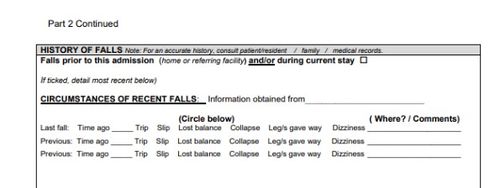The Only Guide for Dementia Fall Risk
The Only Guide for Dementia Fall Risk
Blog Article
Facts About Dementia Fall Risk Revealed
Table of ContentsSome Known Incorrect Statements About Dementia Fall Risk 5 Easy Facts About Dementia Fall Risk ShownIndicators on Dementia Fall Risk You Need To KnowSome Known Facts About Dementia Fall Risk.Some Known Details About Dementia Fall Risk
In the community, inadequate street lighting or vulnerable creeks and garbage dumps may likewise trigger mishaps. Autumns Danger Evaluation Tool (FRAT) is a 4-item falls-risk screening tool for sub-acute and domestic care. The FRAT has three areas: drop threat standing, danger aspect checklist, and action plan. A Loss Threat Standing consists of data about history of current drops, medicines, mental and cognitive status of the patient.If the patient ratings on a danger factor, the equivalent number of points are counted to the patient's loss danger rating in the box to the far. If an individual's loss threat score totals 5 or higher, the individual is at high danger for falls. If the individual scores just four factors or lower, they are still at some danger of falling, and the registered nurse should utilize their best professional evaluation to manage all autumn threat aspects as component of an alternative treatment plan.
These typical strategies, in general, help establish a risk-free atmosphere that minimizes unintended drops and marks core preventative actions for all patients. Indicators are vital for patients at risk for drops.
Dementia Fall Risk Things To Know Before You Buy
Wristbands need to include the client's last and first name, day of birth, and NHS number in the UK. Just red shade must be utilized to signify special person status.
Items that are as well much may require the individual to connect or ambulate needlessly and can possibly be a danger or add to falls. Helps protect against the patient from heading out of bed with no assistance. Nurses reply to fallers' call lights much more rapidly than they do to lights launched by non-fallers.
Aesthetic problems can considerably create falls. Hip pads, when used correctly, might reduce a hip fracture when autumn happens. Keeping the beds closer to the flooring lowers the danger of drops and severe injury. Putting the mattress on the flooring dramatically minimizes loss danger in some medical care settings. Reduced beds are made to lessen the range an individual falls after moving out of bed.
The Basic Principles Of Dementia Fall Risk
People who are high and with weak leg muscle mass that try to remain on the bed from a standing placement are most likely to drop onto the bed since it's too low for them to decrease themselves safely. If a tall person efforts to get up from a reduced bed without help, the client is likely to drop back down onto the bed or miss the bed and drop onto the flooring.
They're designed to advertise prompt rescue, not to stop falls from bed. Aside from bed alarm systems, enhanced guidance for high-risk people likewise may help stop falls.

Clients with an evasion gait boost autumn opportunities considerably. To reduce autumn threat, footwear ought to be with a little to no heel, slim soles with slip-resistant step, and support the ankles.
What Does Dementia Fall Risk Do?
People, especially older adults, have reduced visual capacity. Lighting an unfamiliar environment helps increase visibility if the client should rise during the night. In a study, homes with adequate lighting record fewer drops (Ramulu et al., 2021). Renovation in lights in the house might minimize autumn rates in older adults (Dementia Fall Risk). Using stride belts by all healthcare carriers can advertise safety and security when helping clients with transfers from bed to chair.

Caretakers work for ensuring a secure, safeguarded, and risk-free environment. Nonetheless, research studies demonstrated extremely low-certainty evidence that caretakers decrease loss danger in acute treatment healthcare facilities and only moderate-certainty that options like video monitoring can minimize sitter usage without increasing loss risk, recommending that sitters are not as valuable as at first thought (Greely et al., 2020).
The Definitive Guide for Dementia Fall Risk

Raised physical conditioning minimizes the threat for drops and restricts injury that is sustained when autumn takes place. Land and water-based workout programs might be in a similar way advantageous the original source on balance and stride and therefore reduce the risk for falls. Water exercise may contribute a positive benefit on balance and gait for ladies 65 years and older.
Chair Surge Workout is a straightforward sit-to-stand workout that helps strengthen the muscles in the thighs and buttocks and improves mobility and self-reliance. The goal is to do Chair Rise workouts without making use of hands as the customer comes to be stronger. See sources section for a comprehensive direction on exactly how to execute Chair Increase workout.
Report this page